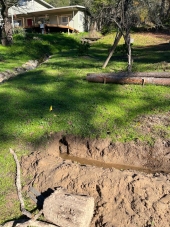How sandy are we talking? Sand dunes sandy or bad soil sandy? I'm going to assume bad soil sandy but let me know. If you have enough soil for them to root in, birch trees might take hold if there's water available. I'm also assuming you don't want a monoculture since that's been a huge problem for China. One disease wiped out decades of plantings because they planted the same exact thing for 20+ years.
What's actually growing in your area now? Look at fence rows and vacant lots to see what's doing fine "in the wild" with similar conditions. Talk to your county's agricultural extension office. They should be able to point you to places where you can get suitable native plants.
Don't be afraid to use some mechanical means of managing soil. Low tight fences around smaller plots help reduce wind-driven evaporation and block blowing sand. I also seem to recall that a lot of burlap bags were used to bury organics around the plantings, forcing the plants to grow toward the nutrients.
https://www.science.org/do/10.1126/science.abh0329/abs/ma_0212_nf_greenwall-preview.jpg
Look at some of the beach area natives for those super sandy spots. It might not handle the cold weather but it will take the heat and sand so you can treat them like annuals. Even if the plant itself dies at the end of the growing season, the roots should persist through the winter.
Don't underestimate native vines like Railroad Vine, either. Vines, when allowed to go across the ground can cover space quickly. There's a reason that a lot of landscapers use jasmine for erosion control. You don't have to plant jasmine but don't overlook native vines from your area. That might be a wild grape or native honeysuckle. Native honeysuckle isn't nearly as invasive as its Asian cousins.
Also, check out the local sages and mints. Sages (Salvias) and Mints (from bee balm to pennyroyal) are some seriously tough plants. I've yet to see a place they won't grow if you find the right varieties. Antarctica maybe but I wouldn't be surprised to find some that figured out how to grow under the ice.











